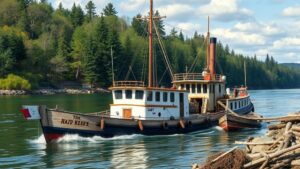Using Early Waterway Blueprints to Locate Submerged Relic Hotspots
Using Early Waterway Blueprints to Locate Submerged Relic Hotspots
Submerged relics, remnants from past civilizations or significant historical events, offer an invaluable glimpse into human history. The study and exploration of these relics require innovative approaches to effectively identify and locate potential hotspots. One such method is the utilization of early waterway blueprints. e historical maps can reveal invaluable information about past human activity and infrastructural elements, aiding researchers and archaeologists in locating submerged relics.
The Importance of Waterway Blueprints
Waterway blueprints serve as foundational documents that illustrate the development of waterways throughout history. Often created for navigation or commercial purposes, these maps document the geography and infrastructure of rivers, lakes, and canals. A study by Brunner and Gratz (2019) highlighted how cartographical records from the 18th and 19th centuries can provide critical insights into long-lost cities and trade routes now submerged under water bodies.
Historical Context and Case Studies
Research on submerged relics has a long history, but the integration of waterway blueprints offers a novel direction. As an example, consider the construction of the Suez Canal in 1869, where pre-canal maps elucidate the settlements and trade routes previously established along the isthmus. Archaeological expeditions have since employed these maps to locate artifacts from ancient Egyptian trade networks near submerged areas of the canal.
Similarly, studies conducted in the Great Lakes region of North America have demonstrated how 19th-century shipping maps offer insights into lost shipwrecks and submerged harbors that once served thriving economies. For example, researchers identified over 15 significant shipwreck sites around Point Pelee, Ontario, through the analysis of historical shipping routes from early blueprints.
Methodology for Utilizing Blueprints in Underwater Archaeology
The methodology for using early blueprints to locate submerged relic hotspots typically involves several systematic steps:
- Collection of historical waterway blueprints.
- Georeferencing maps to align them with modern geographic information systems (GIS).
- Analysis of discrepancies between current topography and historical records to identify potential hotspots.
- Conducting underwater surveys at targeted locations using sonar and ROV technology.
For example, at Lake Ontario, researchers employed historical maps in combination with sonar imaging techniques, resulting in the discovery of at least seven previously unknown submerged structures that date back to the early 1800s.
Challenges and Limitations
While employing early blueprints is certainly beneficial, the approach does not come without challenges. One significant issue is the accuracy of historical maps, which were often drawn with limited scientific knowledge and could contain substantial errors. Migration of riverbanks, sedimentation, and human intervention further complicate matters, potentially leading to misidentified hotspots.
Also, the legal and ethical implications of underwater archaeology can pose additional challenges; researchers must navigate regulations that govern the excavation and preservation of submerged artifacts. In many regions, salvage laws dictate the conditions under which underwater relics can be studied or recovered.
Conclusion
Utilizing early waterway blueprints presents a valuable strategy for the identification and exploration of submerged relic hotspots. integration of historical cartographic data with modern archaeological techniques enables researchers to enhance their understanding of historical landscapes and recover artifacts of significant cultural importance. Continued collaboration among historians, archaeologists, and sonar specialists will be crucial to unlocking the mysteries held beneath our waterways.
As a call to action, we recommend that researchers focus on digitizing existing blueprints and applying advanced spatial analysis techniques to enhance the discovery and preservation of submerged relics. By embracing these methodologies, they can ensure a more comprehensive understanding of our collective history while safeguarding the remnants of our past for future generations.


